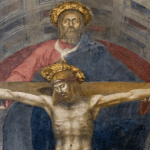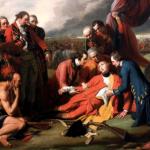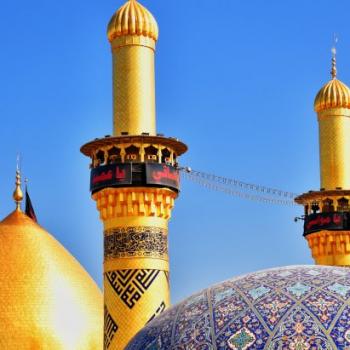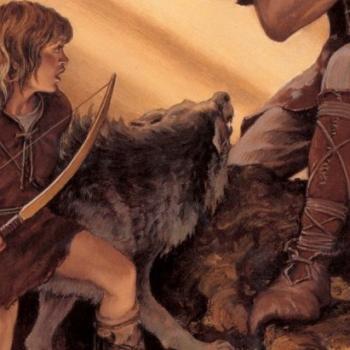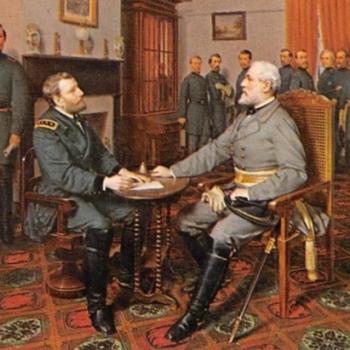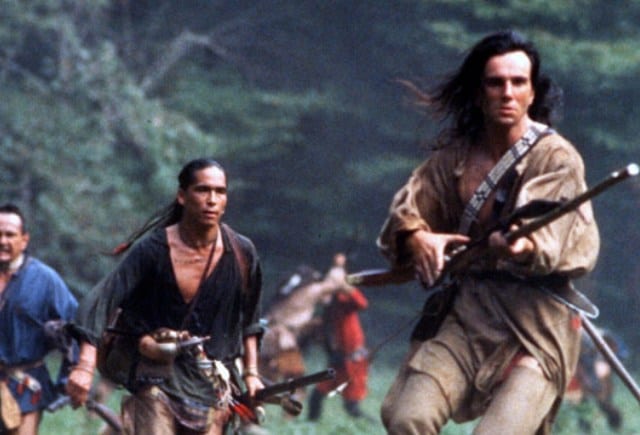
There is painful, and there is very painful. This revisionist cinematic production of James Fennimore Cooper’s The Last of the Mohicans falls into the latter category. Or at least that’s true if historical accuracy, believable acting, and a well-written plot mean anything to the vast array of viewers. Or even the chosen handful of them. But given that’s probably too much to be expected of Holly wood, I apologize for the digression.
The story opens in Colonial America in the midst of The French and Indian War, whereupon we are promptly introduced to Daniel Day-Lewis playing Hawkeye, a buck-skinned frontier scout known as “The Long Carrabine” who looks just a little bit too prettied-up for the part. Traveling with his adopted Mohican father and brother, Chingachgook and Uncas, he makes a pit-stop in a remote settlement where British officers are trying to coerce American colonials to reinforce the defenses of local British forts against the French attacks.
In true stereotypical fashion, the redcoats are portrayed to a man as dandified tyrants, fanatic about their duty to the Crown but with a definite lack of actually fighting skill. The colonists refuse to comply with British demands, saying they will not leave their women and children defenseless at home while they are serving elsewhere. Hawkeye, loitering around in the crowd, also gets his chance to make a Bravheart-like splash by announcing that he doesn’t see himself as “subject to any man”. And here we come to first major bend in the road: unlike previous productions, Hawkeye is most certainly not on the British side.
Realizing he can make a process a lot easier by just lying to the colonials in order to gain their allegiance, British General Webb makes a cursory promise that they can leave to protect their homes should they see fit (accompanied by ominous music and an evil snicker, of course). Then we get our first up-close glimpse of Major Duncan Hayward, a young British officer who we remember for being a nice guy in the book and past film versions, but who has now been transformed into an incorrigible louse with a perpetually sour expression and ill-fitting wig. He also gets to give an overblown debut speech about making “everywhere England”.
Enter Miss Cora Munro, played by the attractive Madeleine Stowe. She is the eldest daughter of the British commanding officer at Fort William Henry, and it is up to Major Hayward, an old family friend, to get her and her younger sister, Alice, safely to the fort and their father. From the get-go, Duncan seems to have an unlucky streak in both love and war, since his marriage proposal to Cora doesn’t particularly exhilarate her and his detachment is subsequently wiped out by renegade Indian scouts.
Duncan and his lady-friends seem doomed to be tomahawked (especially since Duncan is less than athletic in hand-to-hand combat), but then, charging out of the woods just in the nick of time comes the dashing, crashing, man’s man, Hawkeye, who shoots up or scares off all the attackers with the help of Chingachgook and Uncas. Yes, one must wonder how they manage to do what a whole detachment couldn’t do, just as one would wonder how Mel Gibson manages to annihilate a British detachment with just two little kids as back-ups in The Patriot.
But for Cora Munro, logistics clearly don’t matter. Handsome Hawkye is her hero, and love is soon wafting through the wilderness air, as well as wafting through Day-Lewis’ 1990’s California mullet. In keeping with his buoyant perspective when facing set-backs, Duncan begins scheming to reinvigorate his sagging love life by doing away with “The Long Carrabine” (and I can’t say I found myself blaming him much).
By the time everybody makes it to Fort William Henry under the cover of a French barrage, things inside are looking pretty bleak. Colonel Munro, who in the book and other movies is portrayed as a rather proud but basically decent career officer, is remade into a war-criminal who has incurred the particular wrath of a Huron warrior named Magua because of atrocities perpetrated against his tribe. Munro also goes back on the promise to let the Americans go home should their homesteads be attacked, even though the Huron are massacring everyone in their path.
Hawkeye, of course, has to step in here and help some of the colonials escape after a cozy fireside chat where the Americans assert their opposition to tyranny in true revolutionary fashion, even though the foreshadowed revolution is a long way off. For this good deed, Hawkeye is thrown into the fort’s prison and sentenced to hang. Cora makes a gallant effort to plead for his life in front of her father and Duncan, they are quite simply the wrong people to make this pitch to. Duncan even goes so far as to deny that a promise to the Americans was ever made, and his-would-be-fiancée proceeds to disparage him and make a rousing declaration in favor of “freedom” for the colonials.
Cutting to the chase, when the fort finally surrenders to the French, Magua and his Hurons disregard the terms of surrender and slaughter many of the British and American prisoners. Once again, Hawkeye, who conveniently hasn’t been hanged yet, rescues Cora and Alice, and starts paddling up-stream in a convenient canoe that happens to be on-hand. Duncan, also renting a parked canoe, follows in hot pursuit. Yes, the whole thing does look as ridiculous as it sounds. Anyway, after everyone bales out near the rapids and cools off behind a picturesque waterfall, Hawkeye breaks the news to Cora and Alice that their father has had the misfortune of getting his heart cut out by Magua. And speaking of the devil, Magua shows up as if on cue, encircling their waterfall oasis.
“No matter where you go, I will find you!” declares Hawkeye, in order to thematically synchronize with the title song track written by Clannad, and then he and his Mohicans leap through the falls and head for the hills while the girls and dear ol’e Dunc are taken prisoners. But to their credit, it’s not long before Hawkeye and co. show up again at a nearby Huron village where Cora, Alice, and Duncan are about to be burned at the stake. During a long and messy transaction involving walking the gauntlet and using Duncan as a French translator, Hawkeye tries to convince the Huron top-brass to release their prisoners unharmed. The top-brass decide to compromise: Duncan will be released, Alice will remain in captivity, and Cora will be incinerated.
Not a good deal as far as the two rival lovers are concerned, and they start whining in unison, “Take me! Take me!” (I couldn’t help but mentally insert, “Yes, take them, to take me out of my misery!”) Showing impeccable good taste, the Hurons choose Duncan, who has purposely mistranslated Hawkeye’s attempts to offer himself in exchange so that he would be taken instead. This touching gesture of last-minute redemption results in him being raked over the coals, with Cora shrieking “What are they doing to Duncan??” (I mean…it doesn’t take a genius mind…) In the true spirit of throwing someone an anchor when they’re drowning, Hawkeye then uses his marksman to skills to…er…end his rival’s pain.
With only a few more main characters arcs to resolve in a film that’s running overtime, Uncas is killed trying to rescue Alice, Alice jumps off a cliff (no, we don’t know why), and Magua is killed by Chingachgook. With no further ado, Hawkeye and Cora smooch on the bluffs as the sun sets over the wilderness, and Chingachgook makes a few dour predictions about the future demographics of Appalachia since he is, evidently, “The Last of the Mohicans.” Or maybe he’s just saying that to attach himself to The Wild Bill Hickok Show in the future. It’s a non-issue.
By now, you have probably realized I’m not a major fan of this chick-flick-romp-in-the-woods. But even so, I’m going to go the extra mile to say something nice about it. I’ll admit that it does have some appealing visual features. Costuming is good, props are good, sets are good, and scenery is good. One scene that particularly stands out as a majestic display of old-fashioned pageantry was the parlay between Colonel Munro and General Montcalm in which both armies line up in their spit-and-polish best with colorful banners flying against the backdrop of lush forests, dark mountains, and a foreboding cloudy sky.
Also, I must say I absolutely love the music track by Dougie MacLean entitled “The Gael”, which I first heard played by the Royal Scots Dragoon Guards. I think they did a much better job than the actual film rendition, and I feel the tune itself is a thousand times more inspirational than the motion picture to which it has been inextricably attached. More’s the pity; I want to sign a petition to have it rehashed when someone takes the notion to create a good big-budget blockbuster set during The French and Indian War!
As for any spiritual overtones, I suppose I could say that the main characters seem to have a belief in the afterlife, and Chingachgook does offer a memorable prayer to The Great Spirit for the repose of his son’s soul. But that’s small pickings in comparison with James Fennimore Cooper’s novel, which makes numerous references to faithfulness of the characters and their belief in the workings of providence. Traditional Christianity definitely takes a back seat to native spiritual practices in this rendering, and even the latter are sparse and insubstantial.
I guess Duncan sacrificing himself might have been a nice twist, if the rest of the plot hadn’t been so lame. But the fact is it was so lame that there was simply no way to salvage it that late in the game. The romantic triangle totally underwhelmed me by its superficiality and predictability. So many of the other characters had been made unsympathetic or downright detestable at there was basically no one to root for, and the pathetic pop-music-generated dialogue didn’t help much. Acting overall was mediocre, with “E for Effort” going to Jodhi May’s dramatically intense facial expressions before taking her flying leap onto the trampoline below the papier-mâché cliff in her role as Alice.
What the film tried to be, too hard in my opinion, was a drama about the tragedy of war…but because we got no sense of the actual stakes from a historical perspective, except as an outsider looking in, the individuals themselves did not come off as anything more than figures set up to represent a vague motif of “the ravages of colonialism”, which again would have been utterly alien to most of the participants. There was no real conflict tension, because most of the characters didn’t have a clear cause, and those who did were cardboard cut out bad guys. Which of course begs the question…why are we here? Why do we care? Why take a book and completely gut its original dynamic and historical context?
It was impossible to get past this obvious agenda being pushed, portraying the British as monsters with the French not much better. The Indians and American settlers, on the other hand, are portrayed as being equally victimized by Imperialism, who would live in peace and harmony if not for the intervention of the big-bad-big-wigs from Europe. In reality, white settlers had as much, if not more, to gain from the wars of colonial expansion as their British rulers, and this was proven by their resentment of any attempt of British authorities to curtail their incursions into Native American lands. On top of that, we don’t honestly get to “know” the Native American characters beyond their service as props for the rest of the limp and lethargic plot-line.
I have no problem with an honest, critical analysis of European Imperialism and the class system it was built on. But it irks me to no end when self-righteous revisionists try to generalize and condemn whole swaths of people from a different time period because their views did not coincide with present-day political correctness and their customs relied more on ceremonial decorum than is currently fashionable in our jeans-and-tee-shirt society. Even the best ceremonial scenes from The Last of the Mohicans tend to be tinged with an attitude of cynical contempt for the ways of the past and the code of honor which gentleman were taught to follow. By making it all seem stupid and shallow, the film instantly lost touch with the past it was supposed represent.
I am not a book purist, and am usually fairly lenient on film adaptations for their tweaking of original plots. After all, visual dramatization is a different art form from written novelization, and different considerations are needed to make it work. However, this particular film had me yelling at the television set (and threatening to throw a tomahawk at it) nearly the whole time, and I couldn’t be bribed to watch it again. This is because it not only struggled from the same failings as various other big-budget period flicks made in the ’90s, such as Braveheart and Titanic, but it also lacked any of the redeeming qualities of the other two, with little or no clear-cut story direction to follow.
To sum up the problem, when film producers decide to completely “reinvent the wheel” of classic literature, projecting modern perceptions into the past, vilifying characters we used to like, killing off others at random, and then introducing a synthetic romance to plug the holes in their plot, I say the whole enterprise has gotten off message and it’s high time to toss the camera reels in a back-lot ceremonial fire with the incomparably luckless Duncan. So no matter where I go, it is my honest hope that Hawkeye isn’t trying to find me…yeah, that song…did come off like an ode to a stalker sometimes, or the memories of an horror flick we wish we could erase…

